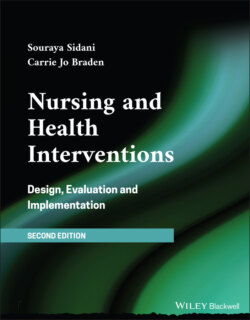Читать книгу Nursing and Health Interventions - Souraya Sidani - Страница 33
2.2.2 Intervention Components
ОглавлениеInterventions are comprised of one or more components. A component is a set of activities or techniques that are directed toward addressing a common goal. For example, the multicomponent intervention for insomnia described in Table 2.2 consists of four components, each addressing one goal: (1) sleep education and hygiene aims to help clients understand the factors that perpetuate insomnia, and the general behavioral and environmental recommendations to promote a good night's sleep; (2) stimulus control therapy focuses on reassociating the bed with sleep; (3) sleep restriction therapy aims to consolidate sleep; and (4) behavior change support is set to facilitate clients' initiation, engagement, and adherence to all treatment recommendations in their daily life context.
TABLE 2.2 Examples of programs or multicomponent interventions.
| Health problem | Chronic insomnia | Stroke and multi‐morbidity | Promotion of physical health |
|---|---|---|---|
| Program/intervention name | Multicomponent intervention | Hospital‐to‐home transitional care intervention | For health, I move in my neighborhood! |
| Description | Sleep education and hygieneDiscussion of factors that contribute to insomniaPresentation of behavioral and environmental recommendations to promote a good night's sleepStimulus control therapyDiscussion of instructions for sleep‐related behaviorsApplication of recommendations in daily lifeSleep restriction therapyIdentification of sleep needsWorking out a sleep–wake scheduleApplication of schedule in daily lifeBehavior change supportIdentification of barriers and strategies to overcome barriers to the application of recommendations in daily lifeSelf‐monitoring of sleep behaviors and sleep parameters | Person‐centered careComprehensive health assessmentMedication review and reconciliationSelf‐management education and supportProvision of caregiver supportCare coordination/system navigationIn‐person (inter‐professional case conferences) and electronic (web‐based application) communication among health professionalsTimely referral to appropriate health professionals and community resources | .Improved offering and accessibility to physical activityProvision of new activities (e.g. walking, yoga) in schoolsCommunication about physical activity (i.e. information about benefits of physical activity)Distribution of flyers or brochuresPhysical activity instructor's visits to different structures (e.g. schools, community centers) and availability for consultationSports festivalEnvironmental changesOrientation pathways (i.e. information on distance and duration of walk to different services)Provision of additional sports devices at community centersUrban redevelopmentRoad work (e.g. bike path, widening sidewalk)Redevelopment of green areas“Shape and Health Challenge” programPhysical and sports activities program |
| Reference | Adapted from Sidani et al. (2019) | Adapted from Markle‐Reid et al. (2019) | Adapted from Buscail et al. (2016) |
There are two categories of intervention components: specific and nonspecific. Specific components are unique and essential in distinguishing the intervention. They represent the “active ingredients,” which are theoretically hypothesized to bring about the intended changes in the health problem and to produce related beneficial outcomes (Carey et al., 2018; Kühne et al., 2015; Michie et al., 2009). The nonspecific components are techniques used to enable, support, reinforce, or facilitate the implementation of the intervention's specific components (Sidani et al., 2020). Nonspecific components are usually not unique to a particular intervention and, therefore, are not expected to contribute significantly to the intended beneficial outcomes (Araújo‐Soares et al., 2018). Recent evidence, however, suggests that nonspecific components, in combination with the way the intervention is delivered, may enhance or undermine its effectiveness (Dombrowski et al., 2016). For example, sleep education and hygiene, stimulus control therapy and sleep restriction therapy are specific components of the multicomponent intervention for insomnia. The behavior change support is a nonspecific component because it is generic and can be integrated in other health behavior change interventions.
